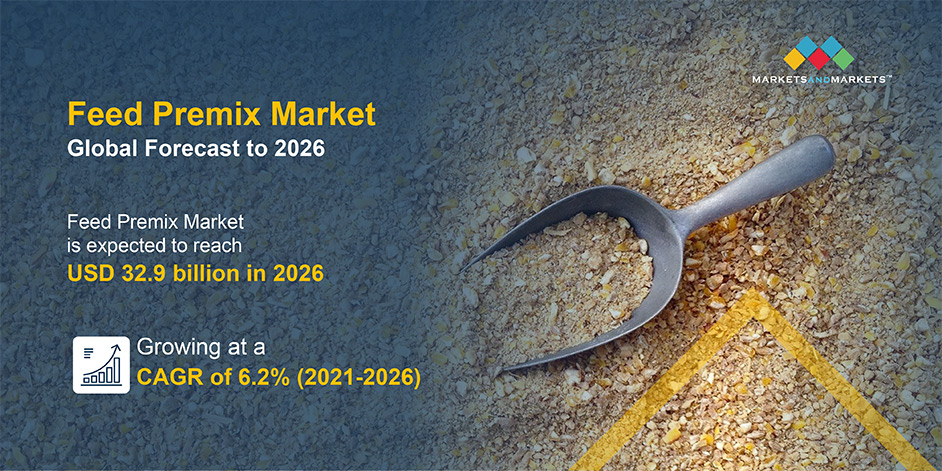The feed premix market size is predicted to grow at a CAGR of 6.2% between 2021 and 2026, reaching a value of $32.9 billion by 2026 from a projection of $24.3 billion in 2021. The global feed premix market is expected to grow due to various factors, including increasing demand for animal protein, rising awareness of animal nutrition and health concerns, technological advancements, and the adoption of intensive animal farming practices. As consumers become more conscious about the quality and safety of animal-derived products, the demand for feed premixes to enhance animal health and productivity is increasing. Advances in technology have led to the development of more sophisticated and effective feed premix products, which are expected to further drive the growth of the market.

Feed Premix Market Opportunities: Developing countries emerge as strong consumers of feed premix
The demand from emerging markets such as Asia Pacific and Latin America accounted for a combined global share of ~47% in 2017. The population of developing countries in the Asia Pacific region—such as India, China, Indonesia, Vietnam, and Thailand—are expected to consume meat at an annual rate of 2.4% till 2030, according to the FAO report on “World Agriculture: Towards 2015/2030.” This has increased the demand for high-quality feed concentrates and premixes to enhance the meat weight and quality of the animals.
Key players in the premix market have sensed this opportunity to start premix production plants in these regions, to meet the growing demand for feed premixes. Similarly, in South America, Brazil had the largest cattle population in 2017, with a headcount of 330 million, and is projected to grow at a rate well above the regional average, according to the FAO. It is expected that the rising consumer awareness for nutritious products and requirement for export quality meat products can establish a strong demand for feed premixes.
Download PDF Brochure: https://www.marketsandmarkets.com/pdfdownloadNew.asp?id=170749996
Feed Premix Market Challenge: Sustainability of feed and livestock chain
The global feed industry focuses on improving feed efficiency by improving feed conversion rates for all major livestock and farmed fish species. The feed and livestock industries can achieve sustainability by developing a harmonized environmental footprint methodology based on life cycle analysis involving the entire chain. The development of common metrics can also help to calculate a broader range of resource efficiency indicators. The efficient usage of feed ingredients can support the reduction of the environmental impact of livestock farming through resource-efficient feed production. The use of co-products from other processing industries can reduce the pressure on land-grown crops.
Some requirements of an efficient feed and livestock chain include the following:
- Access to safe and cost-effective feed and services
- clear and transparent legislative framework
- Improved image (animal welfare, quality, and safety of animal products)
- Innovating approaches to mitigate the environmental impact of production systems
- Continuously improving working conditions
- Bringing innovative science to the marketplace
Global organizations such as the International Feed Industry Federation (IFIF) have developed a number of strategic initiatives to measure and benchmark the environmental performance of the livestock production chain. IFIF is a founding member of the Global Feed LCA Institute (GFLI), which will use the FAO LEAP methodology to develop a global standard for assessing and benchmarking the impact of the feed industry to support the reduction of the environmental footprint of livestock products.
Make an Inquiry: https://www.marketsandmarkets.com/Enquiry_Before_BuyingNew.asp?id=170749996
By livestock, the poultry segment dominated the global feed premix market
The poultry industry consists of four main areas of production—broiler, eggs, pullets, and breeders. It is a fast-evolving industry due to the rapid increase in demand for poultry meat, particularly in India and many Islamic countries. In these countries, the consumption of porcine and livestock meat (India) is projected to be low due to religious beliefs, which, in turn, increases the demand for poultry meat.
In addition, the global demand for poultry meat is further set to rise in the coming years due to the increased cost and reduced availability due to the rise in demand for beef and pig meat. Poultry, the most traded meat category, accounts for over 40% of the total meat trade. According to the FAO, global poultry meat production was nearly 111.8 million tons in 2015. Furthermore, the demand for poultry meat is projected to remain high in developing economies.
Asia Pacific is the fastest-growing region during the forecast period in the global feed premix market
The Asia Pacific region accounted for the largest share of 35.6% of the global market in 2020, in terms of value. The market in the region is driven by the presence of a large livestock population (FAO 2016) and their growth rate. Furthermore, the region has witnessed an increase in the number of feed mills and feed production, particularly in India and Japan. This increase in the number of feed mills in the region reflects the growth in feed production. According to the Alltech Feed Survey of 2018, the region experienced a 7% increase in its feed production, from 356.5 million tons in 2012 to 381.1 million tons in 2017. The largest feed producer, China, contributes significantly to the region’s leading position, with Thailand and Indonesia being the emerging feed-producing countries, while India and Japan are demonstrating constant growth in feed production. According to the same source, among the top 20 feed companies in the world, 16 of them are based in the Asia Pacific region, which makes this a highly competitive market.
Top Companies in the Feed Premix Market
This report includes a study on the marketing and development strategies, along with a study on the product portfolios of the leading companies operating in the feed premix. It consists of the profiles of leading companies such as Koninklijke DSM N.V. (Netherlands), Nutreco N.V. (Netherlands), Cargill (US), Archer Daniels Midland Company (ADM) (US), BEC Feed Solutions (Australia), DLG Group (Denmark), Charoen Pokphand Foods PCL (Thailand), Land O’Lakes (US), and AB Agri Ltd. (UK).


